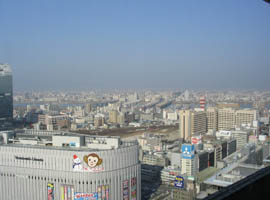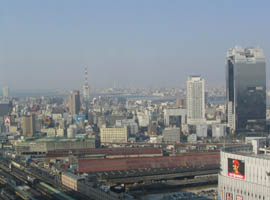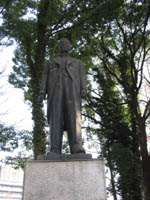The Man Who Tried to Save Osaka
Back to Contents of Issue: March 2004
|
|
|
|
by Dominic Al-Badri |
|
|
Osaka, alas, has neither. The firebombing of the city in the later stages of World War II might have offered urban planners a chance to remodel the city's image during the postwar reconstruction period. But the opportunity was not grabbed, and today vast swathes of the city are of an ugly, boxy uniformity.
Japan's position as one of Asia's leading developed economies ensures that officials and students from less developed countries in the region continue to come here to learn and study. Urban planning is once again rising in popularity, and 2003 saw two series of seminars and workshops held in Kobe under the auspices of a United Nations-related NGO: the Asian Urban Information Centre of Kobe (AUICK).
Filthy gases
Though long forgotten now, Osaka was once commonly referred to as the "Manchester of the Orient," a reference to the then mighty industrial city in northern England, not least because of its thousands of smokestacks belching out filthy gases. Urban planning in Osaka, at least until 1919, consisted solely of the construction of roads and trolley lines, with cities seen primarily as centers of economic growth, progress and prosperity.
As the city boomed, so did its population, quadrupling in size from 332,000 in 1882 to 1.4 million in 1913. A further economic boom brought on by the advent of World War I saw yet more expansion, a big increase in the number of factories in the southern part of the city and a mass influx of migrant laborers searching for a pot of gold in the Dickensian slums.
The workers' wretched dwellings struck a chord in Seki, a well-heeled member of the elite. During his time as deputy mayor, he was responsible for the municipalization of the city's electricity and the modernization of municipal and regional transport systems. Yet his overriding concern was for the welfare of the working classes.
Hampered in his efforts to initiate radical urban reform by the lack of an official policy (and the absence of laws authorizing municipal control over land usage), Seki's chance finally came in 1918, when rice riots and labor unrest enabled him to take action.
Out of this chaos arose Seki's vision of urban social reform. Over the next few years, the construction of numerous institutions and facilities -- including hospitals, public baths, nurseries and municipal housing -- put Osaka firmly in the vanguard of enlightened urban planning in Japan.
Though pleased with the progress, Seki had larger ambitions. In the 17th century, the Tokugawa Shogunate had redefined Osaka's urban spatiality; part of this had included the clear designation of temple and commercial zones as component sectors of a unified plan. But during the intervening years lax authorities had let this slip. The city's outer districts had descended into poverty and disarray, epitomized by the slums and tenements the working classes were forced to inhabit.
Much of contemporary Japan's urban sprawl can be traced back to the ineffective planning in the first decades of the last century, when the undeveloped areas on the edges of cities were up for grabs. With no official municipal policy to guide or restrict them, private developers did as they wished with this exurban land, haphazardly building low-quality housing and factories.
In order to jump one step ahead of the property developers, Seki wanted to build low-cost, high-quality municipal housing on undeveloped land to provide a pleasant environment for the working classes. Seki became mayor in 1923, finally acquiring the power to push through his reforms.
Livable city
The suburbs Seki had dreamed about did eventually come about beyond the borders of the city; many were strung out along the private railway lines which began snaking across the Kansai region. But unfortunately, the new suburban inhabitants were not the working classes but the middle classes -- those who had bought into the dream of satellite residential communities offered by the likes of the Hankyu and Keihan corporations.
Today, with a population several times what it was in Seki's heyday, Osaka has dealt with many of its problems -- though homelessness and slums remain, hidden from sight in the less frequented districts in the south of the city. There are few urban environments in the world uglier than Japan's, and many today must rue the fact that Seki's vision wasn't even partially realized.
Whatever lessons the nation's current urban and social planners try to teach students from Asia's developing nations, we sincerely hope the alleged benefits of unchecked urban sprawl are not among them.
@
|
|
Note: The function "email this page" is currently not supported for this page.


 EVEN BY JAPANESE STANDARDS, Osaka is not an attractive city. To be sure, Kansai's two other major conurbations, Kyoto and Kobe, have their fair share of ugliness. But Kyoto has a storied beauty best appreciated at the micro level, while Kobe offers striking vistas from the pricier houses atop the Rokko mountain range.
EVEN BY JAPANESE STANDARDS, Osaka is not an attractive city. To be sure, Kansai's two other major conurbations, Kyoto and Kobe, have their fair share of ugliness. But Kyoto has a storied beauty best appreciated at the micro level, while Kobe offers striking vistas from the pricier houses atop the Rokko mountain range.
 From chaos
From chaos
 Though Seki oversaw the completion of Osaka's first municipal subway line in 1933, and the controversial construction of the enormous Midosuji boulevard (which, like New York's Broadway, still cuts a north-south thoroughfare through the city), his dreams of redefining Osaka had been diminished. After a fierce typhoon hit the city in September 1934, Seki quickly faded, dying of typhoid a few months later in January 1935.
Though Seki oversaw the completion of Osaka's first municipal subway line in 1933, and the controversial construction of the enormous Midosuji boulevard (which, like New York's Broadway, still cuts a north-south thoroughfare through the city), his dreams of redefining Osaka had been diminished. After a fierce typhoon hit the city in September 1934, Seki quickly faded, dying of typhoid a few months later in January 1935.



